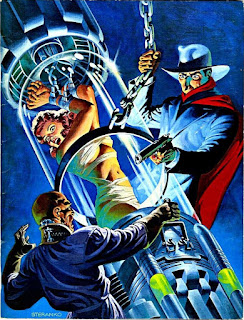Sunday, May 22, 2016
Saturday, May 21, 2016
1408
MURDER TRAIL
Friday, May 13, 2016
CASTING THE SHADOW
The next phone call would be to artist Jim Steranko. He would be hired as art director/production designer and in charge of making sure that the various sets, costumes, props and locations looked as much like his incredible paintings as possible.
Unlike Batman, The Shadow didn't have a huge gallery of rogues to contend with. Almost all of his foes were "one-hit-wonders" (usually dispatched by the Shadow's twin automatics!) with only one recurring villain, the evil Oriental mastermind Shiwan Khan. Who better to play this arch fiend than Khigh Dhiegh, who played a similar role as "Wo Fat" on HAWAII FIVE-O.
Two members of the Shadow's supporting cast were law enforcement officials. As Commissioner Weston (who was played by Jonathan Winters in the 1994 film) I would cast veteran character actor (STAR TREK, BATMAN (False Face!) and TO CATCH A THIEF), Malachi Throne.
And as Detective Joe Cardona, Robert (T.H.E. CAT) Loggia.
Burbank ran the Shadow's communications network, relaying messages to and from the Shadow and his various agents. Although seldom a featured player in any of the novels (at least not in the ones I've read thus far), he nonetheless played a vital part in the Shadow's war against crime. He was faithful, loyal and dependable, all qualities that were embodied by the wonderful character actor (and sadly, recently deceased) William Schallert.
Rutledge Mann was a quiet, reserved stock broker who also served as an agent of the Shadow. He rarely became physically involved in an adventure but he did ferret out important information and oversaw a certain mail drop. A perfect role for Tom Bosley.
When the Shadow needed to get around Manhattan, he often depended on Shrevvy, a tough, New York cab driver who knew every inch of the city and then some. I submit that Roy Thinnes would have been good as the hard nosed cabbie.
Cliff Marsland, an innocent man who served time in prison before being exonerated by the Shadow, was often dispatched into the "bad lands" of the underworld to spy for the Shadow. Marsland had the chops to be credible as a smooth, suave, sophisticated type of gangster. Rick Jason, anyone?
Harry Vincent was the first agent The Shadow recruited and he appears in more Shadow novels than any other supporting character. A suicidal young man, Vincent was stopped from taking a fatal plunge off of a bridge by The Shadow in the opening pages of the very first Shadow novel, THE LIVING SHADOW. Vincent, owing his life to this mysterious creature of the night, swore his undying allegiance to his savior and was The Shadow's most trusted agent. Who better to play this role than James MacArthur?
Margo Lane was more a fixture on The Shadow radio program than the pulps but she did appear in some adventures and provided a much needed female presence in this all-male bunch of characters. I think the lovely Suzanne Pleshette would have made a great Margo.
Finally, we get to the star of our show, The Shadow aka Lamont Cranston. I know, I know, Cranston wasn't The Shadow's real identity, it was just one that he borrowed from time to time. But thanks to the radio program and other media iterations of the character, Lamont Cranston is, for better or worse, The Shadow. And who better to embody this weird avenger of the night than Lloyd Bochner.
There you have it folks. What do you think? I know I would have watched a SHADOW TV show with this cast in the 1960s.
Wednesday, May 11, 2016
ANOTHER FAVORITE BRUNETTE
Tuesday, May 10, 2016
THE LAST STAND
Saturday, May 7, 2016
THE PROPOSITION
Sunday, May 1, 2016
SWIPES ARE WHERE YOU FIND THEM
HOLD YOUR NOSE
Subscribe to:
Posts (Atom)






















